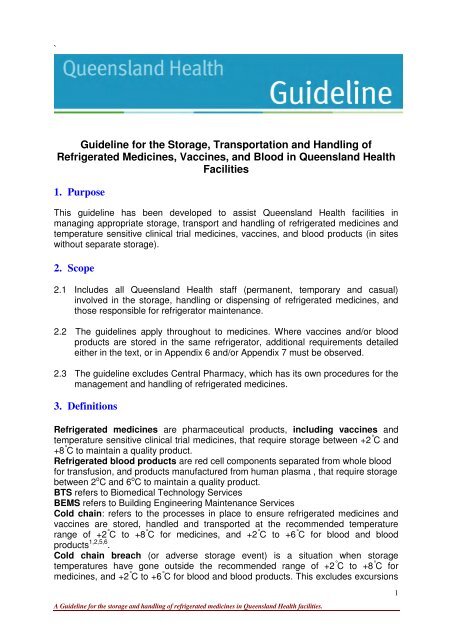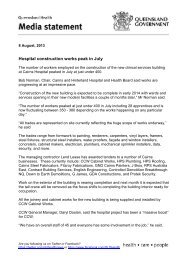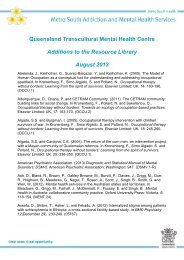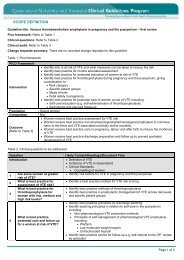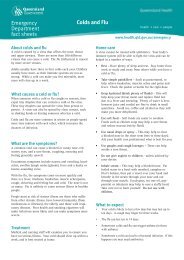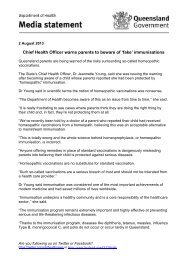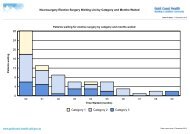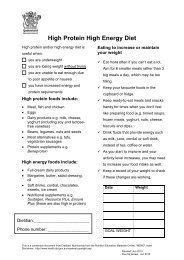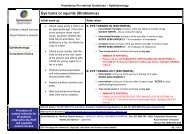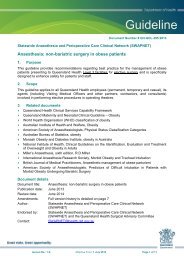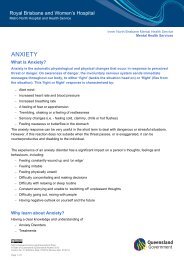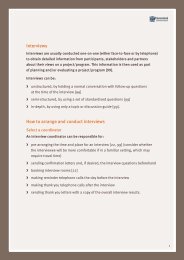Guidelines for the Storage, Transportation and Handling of ...
Guidelines for the Storage, Transportation and Handling of ...
Guidelines for the Storage, Transportation and Handling of ...
You also want an ePaper? Increase the reach of your titles
YUMPU automatically turns print PDFs into web optimized ePapers that Google loves.
`<br />
Guideline <strong>for</strong> <strong>the</strong> <strong>Storage</strong>, <strong>Transportation</strong> <strong>and</strong> H<strong>and</strong>ling <strong>of</strong><br />
Refrigerated Medicines, Vaccines, <strong>and</strong> Blood in Queensl<strong>and</strong> Health<br />
Facilities<br />
1. Purpose<br />
This guideline has been developed to assist Queensl<strong>and</strong> Health facilities in<br />
managing appropriate storage, transport <strong>and</strong> h<strong>and</strong>ling <strong>of</strong> refrigerated medicines <strong>and</strong><br />
temperature sensitive clinical trial medicines, vaccines, <strong>and</strong> blood products (in sites<br />
without separate storage).<br />
2. Scope<br />
2.1 Includes all Queensl<strong>and</strong> Health staff (permanent, temporary <strong>and</strong> casual)<br />
involved in <strong>the</strong> storage, h<strong>and</strong>ling or dispensing <strong>of</strong> refrigerated medicines, <strong>and</strong><br />
those responsible <strong>for</strong> refrigerator maintenance.<br />
2.2 The guidelines apply throughout to medicines. Where vaccines <strong>and</strong>/or blood<br />
products are stored in <strong>the</strong> same refrigerator, additional requirements detailed<br />
ei<strong>the</strong>r in <strong>the</strong> text, or in Appendix 6 <strong>and</strong>/or Appendix 7 must be observed.<br />
2.3 The guideline excludes Central Pharmacy, which has its own procedures <strong>for</strong> <strong>the</strong><br />
management <strong>and</strong> h<strong>and</strong>ling <strong>of</strong> refrigerated medicines.<br />
3. Definitions<br />
Refrigerated medicines are pharmaceutical products, including vaccines <strong>and</strong><br />
temperature sensitive clinical trial medicines, that require storage between +2 ° C <strong>and</strong><br />
+8 ° C to maintain a quality product.<br />
Refrigerated blood products are red cell components separated from whole blood<br />
<strong>for</strong> transfusion, <strong>and</strong> products manufactured from human plasma , that require storage<br />
between 2 o C <strong>and</strong> 6 o C to maintain a quality product.<br />
BTS refers to Biomedical Technology Services<br />
BEMS refers to Building Engineering Maintenance Services<br />
Cold chain: refers to <strong>the</strong> processes in place to ensure refrigerated medicines <strong>and</strong><br />
vaccines are stored, h<strong>and</strong>led <strong>and</strong> transported at <strong>the</strong> recommended temperature<br />
range <strong>of</strong> +2 ° C to +8 ° C <strong>for</strong> medicines, <strong>and</strong> +2 ° C to +6 ° C <strong>for</strong> blood <strong>and</strong> blood<br />
products 1,2,5,6 .<br />
Cold chain breach (or adverse storage event) is a situation when storage<br />
temperatures have gone outside <strong>the</strong> recommended range <strong>of</strong> +2 ° C to +8 ° C <strong>for</strong><br />
medicines, <strong>and</strong> +2 ° C to +6 ° C <strong>for</strong> blood <strong>and</strong> blood products. This excludes excursions<br />
A Guideline <strong>for</strong> <strong>the</strong> storage <strong>and</strong> h<strong>and</strong>ling <strong>of</strong> refrigerated medicines in Queensl<strong>and</strong> Health facilities.<br />
1
up to +12 ° C, lasting no longer than 15 minutes, when stock taking or restocking)<br />
GMP refers to Good Manufacturing Practice<br />
GDP refers to Good Distribution Practice<br />
NVSG: National Vaccine <strong>Storage</strong> <strong>Guidelines</strong><br />
QH: Queensl<strong>and</strong> Health<br />
QHIP: Queensl<strong>and</strong> Health Immunisation Program<br />
The St<strong>and</strong>ard: Medical refrigeration equipment- <strong>for</strong> <strong>the</strong> storage <strong>of</strong> blood <strong>and</strong> blood<br />
products Australian St<strong>and</strong>ard AS 3864-1997<br />
4. Background<br />
All medicines must be stored <strong>and</strong> h<strong>and</strong>led in accordance with <strong>the</strong> manufacturer’s<br />
guidelines in order to maintain <strong>the</strong> quality <strong>of</strong> <strong>the</strong> product. The World Health<br />
Organization (WHO) recommends special storage conditions, such as <strong>the</strong> need <strong>for</strong><br />
refrigeration, are checked <strong>and</strong> monitored to ensure appropriate data is recorded<br />
(correct storage) <strong>for</strong> refrigerated medicines 7 . Manufacturers must follow good<br />
manufacturing practice (GMP) during production, storage <strong>and</strong> transportation 1,2,3,4,11,13<br />
<strong>and</strong> it is essential that Queensl<strong>and</strong> Health (QH) facilities store <strong>and</strong> h<strong>and</strong>le<br />
refrigerated medicines in optimal conditions to provide a quality product <strong>for</strong> <strong>the</strong><br />
patient 15,16 . <strong>Storage</strong> outside <strong>the</strong> recommended temperature range can result in<br />
chemical <strong>and</strong>/ or physical changes to <strong>the</strong> product which may lead to a loss <strong>of</strong> efficacy<br />
<strong>and</strong>/or altered patient response with potential to cause harm to patients.<br />
Inappropriate storage <strong>and</strong> h<strong>and</strong>ling practices <strong>of</strong> refrigerated medicines may result in<br />
potential spoilage <strong>of</strong> <strong>the</strong> medicines <strong>and</strong> consequent financial impact <strong>for</strong> <strong>the</strong> facility eg<br />
insulin <strong>and</strong> products <strong>of</strong> biotechnology require refrigeration <strong>and</strong> are generally high cost<br />
medicines. Incorrect storage <strong>and</strong> consequent disposal <strong>of</strong> <strong>the</strong>se medicines may have<br />
a significant impact on <strong>the</strong> budget <strong>of</strong> <strong>the</strong> facility, <strong>the</strong>ir ability to opportunistically<br />
vaccinate or treat patients.<br />
This document supercedes <strong>the</strong> previous Queensl<strong>and</strong> Health Policy Statement titled<br />
Maintenance <strong>of</strong> <strong>the</strong> Vaccine Cold Chain modified on <strong>the</strong> 17 May 2005.<br />
5. Principles<br />
There is currently no Australian St<strong>and</strong>ard <strong>for</strong> refrigeration equipment <strong>for</strong> <strong>the</strong> storage<br />
<strong>of</strong> refrigerated medicines or vaccines. Australian St<strong>and</strong>ard AS3864-1997 applies to<br />
storage <strong>of</strong> blood <strong>and</strong> blood products. 1°<br />
The NVSG must be complied with <strong>for</strong> vaccines. However, AS3864 contains a number<br />
<strong>of</strong> relevant points that will guide <strong>the</strong> storage <strong>of</strong> all three categories or product, such<br />
as:<br />
• A temperature recording system is in place in <strong>the</strong> refrigeration equipment <strong>and</strong><br />
that this is checked at least daily (but preferably twice daily) using chart <strong>and</strong>/or<br />
digital recording methods or a manual record <strong>of</strong> temperature.<br />
• For refrigerators without inbuilt probes, <strong>the</strong> temperature probe must be located<br />
in <strong>the</strong> warmest part <strong>of</strong> <strong>the</strong> refrigerator; this is generally <strong>the</strong> front top portion,<br />
unless advised o<strong>the</strong>rwise in <strong>the</strong> manufacturer’s documentation.<br />
A Guideline <strong>for</strong> <strong>the</strong> storage <strong>and</strong> h<strong>and</strong>ling <strong>of</strong> refrigerated medicines in Queensl<strong>and</strong> Health facilities.<br />
2
• The target temperature <strong>of</strong> <strong>the</strong> refrigerator equipment is set as close as<br />
possible to +4 ° C <strong>for</strong> blood products <strong>and</strong> +5 ° C <strong>for</strong> medicines <strong>and</strong> vaccines.<br />
• Alarm points are set at +2.5 ° C <strong>and</strong> +7.5 ° C (+5.5 ° C <strong>for</strong> blood products), to alert<br />
to instances <strong>of</strong> temperature breaches outside this range.<br />
• The refrigerator alarm function is checked weekly via a process developed in<br />
conjunction with hospital maintenance services, or with <strong>the</strong> supplier, <strong>and</strong> detail<br />
<strong>of</strong> <strong>the</strong> check is recorded in an appropriate manner as per Appendix 2.<br />
• The refrigeration system device that controls <strong>the</strong> refrigerator cooling is<br />
separate from any temperature alarm/ temperature recording equipment 1°<br />
such that <strong>the</strong> failure <strong>of</strong> one shall have no effect on <strong>the</strong> continued per<strong>for</strong>mance<br />
<strong>of</strong> <strong>the</strong> o<strong>the</strong>r.<br />
• A check <strong>of</strong> <strong>the</strong> calibration <strong>of</strong> <strong>the</strong> refrigeration equipment must be conducted no<br />
less than annually by an approved QH service provider e.g. Biomedical<br />
Technology Services (BTS) or Building Engineering Maintenance Services<br />
(BEMS).or by <strong>the</strong> Supplier<br />
• A process is in place to ensure refrigerated medicines are kept not less than<br />
4cm from <strong>the</strong> back-plate <strong>and</strong> <strong>for</strong> confirming with <strong>the</strong> manufacturer whe<strong>the</strong>r<br />
refrigerated medicine(s) can be stored in <strong>the</strong> bottom <strong>of</strong> <strong>the</strong> refrigerator 5,7 .<br />
• If refrigerated medicines occupy only a small proportion <strong>of</strong> <strong>the</strong> refrigerator<br />
space it is necessary to add sufficient <strong>the</strong>rmal mass. Use as many bottles <strong>of</strong><br />
water or 0.9% sodium chloride in <strong>the</strong> vacant space to ensure even<br />
temperature is maintained throughout <strong>the</strong> refrigerator.<br />
6. Process<br />
6.1 <strong>Transportation</strong> <strong>of</strong> Refrigerated medicines to outreach clinics <strong>and</strong>/or smaller<br />
regional QH Facilities<br />
All QH staff <strong>and</strong> contractors need to ensure <strong>the</strong> following:<br />
• Refrigerated medicine <strong>for</strong> transportation outside <strong>the</strong> building from where<br />
<strong>the</strong>y are supplied must be monitored with appropriate devices that will<br />
indicate exposure to 0 ° C <strong>and</strong> temperatures >+8 ° C when packed <strong>and</strong> in<br />
transit to ensure that <strong>the</strong> temperature range is maintained between +2 ° C<br />
<strong>and</strong> +8 ° C 11, 12 .<br />
• H<strong>and</strong>ling <strong>and</strong> transportation time to <strong>the</strong> destination should be kept to a<br />
minimum to ensure that <strong>the</strong> refrigerated medicine maintains optimal<br />
efficacy. Appendix 1 provides in<strong>for</strong>mation on suitable packaging processes<br />
<strong>for</strong> <strong>the</strong> transportation <strong>of</strong> refrigerated medicines.<br />
• Domestic style coolers, eg. Esky or Willow, are not adequate <strong>for</strong><br />
transporting <strong>and</strong> h<strong>and</strong>ling <strong>of</strong> refrigerated medicines <strong>for</strong> longer than 3 to 4<br />
hours.<br />
• If portable fridges are used <strong>for</strong> transportation <strong>of</strong> refrigerated medicines it is<br />
essential that temperature range is maintained between +2 ° C <strong>and</strong> +8 ° C<br />
<strong>and</strong> a power supply is available to access in an emergency.<br />
• A temperature monitoring device (eg data logger, minimum/maximum<br />
<strong>the</strong>rmometer or temperature strip) should be used to record <strong>the</strong> minimum<br />
<strong>and</strong> maximum temperature range <strong>of</strong> <strong>the</strong> refrigerated medicine during <strong>the</strong><br />
transportation process. The temperature monitoring device should be<br />
placed in <strong>the</strong> middle <strong>of</strong> <strong>the</strong> package <strong>of</strong> refrigerated medicine. See appendix<br />
1<br />
A Guideline <strong>for</strong> <strong>the</strong> storage <strong>and</strong> h<strong>and</strong>ling <strong>of</strong> refrigerated medicines in Queensl<strong>and</strong> Health facilities.<br />
3
• If using a miminum/maximum <strong>the</strong>rmometer to monitor temperatures during<br />
transport temperatures should be recorded in an outreach Temperature<br />
Log Book available from QHIP<br />
• The temperature monitoring device must be checked on arrival at <strong>the</strong><br />
destination. If a temperature breach has occurred during <strong>the</strong> transportation<br />
process <strong>the</strong>n refer to <strong>the</strong> table below 5, 6 .<br />
• If transport is within a single building, <strong>and</strong> transit time is less than 15<br />
minutes, <strong>the</strong>n <strong>the</strong> products should be transported in an insulated container<br />
(e.g. polystyrene esky or coolbag). No additional cooling or monitoring is<br />
required<br />
Origin <strong>of</strong> product<br />
Reporting a cold chain breach<br />
Responsible organisation Contact<br />
Vaccines supplied by QH<br />
QHIP (Monday to Friday – 3328 9888<br />
Immunisation Program<br />
8am to 4.30pm)<br />
Medications <strong>and</strong> o<strong>the</strong>r vaccines Central Pharmacy (Monday<br />
to Friday 8am to 5pm)<br />
3120 8500<br />
Clinical Trial medicines <strong>and</strong> vaccines Clinical Trial Principal Dependent on<br />
Investigator<br />
investigator<br />
Blood <strong>and</strong> blood products Blood Bank supervisor Supplying<br />
Laboratory<br />
Privately purchased medicines <strong>and</strong><br />
vaccines<br />
Manufacturer Manufacturer<br />
6.2 Breach <strong>of</strong> Temperature Range in <strong>Transportation</strong> to or at a QH Facility<br />
• When a temperature breach is noted <strong>the</strong> affected refrigerated medicines<br />
must be labelled as ‘Not to be used’ <strong>and</strong> isolated in a separate section<br />
<strong>of</strong> <strong>the</strong> refrigerator. The minimum <strong>and</strong> maximum temperature variations<br />
must be documented by <strong>the</strong> observer. Contact <strong>the</strong> relevant body listed<br />
above to report <strong>the</strong> breach <strong>and</strong> <strong>for</strong> fur<strong>the</strong>r advice on how to manage <strong>the</strong><br />
exposed products 5,6,15 . or contact Pharmacist/Director <strong>of</strong> Pharmacy<br />
<strong>for</strong> assistance in obtaining relevant manufacture’s in<strong>for</strong>mation on<br />
drug stability.<br />
• If <strong>the</strong>re is a mechanical issue with <strong>the</strong> refrigeration equipment <strong>the</strong><br />
mechanic must be contacted to undertake necessary <strong>and</strong> appropriate<br />
maintenance work.<br />
• Exceptions:<br />
� If blood <strong>and</strong> blood products are involved in temperature<br />
breaches outside +2°C to +6°C, contact <strong>the</strong> Blood Bank<br />
Supervisor (from laboratory who supplies blood) immediately <strong>and</strong><br />
quarantine <strong>the</strong> blood. This product cannot be used <strong>for</strong> transfusion 16 .<br />
� If Clinical Trial refrigerated medicines are involved in<br />
temperature breaches outside +2°C to +8°C, contact <strong>the</strong> Clinical<br />
Trial Principal Investigator to in<strong>for</strong>m <strong>of</strong> <strong>the</strong> breach <strong>and</strong> to seek<br />
advice.<br />
• All temperature breaches need to be documented in ei<strong>the</strong>r <strong>the</strong> QHIP<br />
Temperature Log Book or <strong>the</strong> Minimum/maximum temperature chart, or as<br />
per Appendix 3 or as per Appendix 4 if blood products are present. Actions<br />
A Guideline <strong>for</strong> <strong>the</strong> storage <strong>and</strong> h<strong>and</strong>ling <strong>of</strong> refrigerated medicines in Queensl<strong>and</strong> Health facilities.<br />
4
taken (e.g. <strong>the</strong> Director <strong>of</strong> Pharmacy or Nurse Unit Manager contacted <strong>and</strong><br />
refrigerated medicines quarantined) must be documented.<br />
• All temperature recording documentation must be retained <strong>for</strong> 10 years in<br />
accordance with QH (clinical records) retention <strong>and</strong> disposal<br />
schedule 16 .The legal requirements <strong>for</strong> refrigerated blood storage differs<br />
from those relating to clinical records with records to be retained <strong>for</strong> 20<br />
years 17 .<br />
In <strong>the</strong> event <strong>of</strong> a power failure <strong>the</strong> refrigeration equipment door should be kept closed<br />
<strong>and</strong> urgent action should be taken to prepare <strong>for</strong> removal <strong>of</strong> medicines to alternative<br />
monitored storage particularly where purpose built refrigerators with glass doors are<br />
in use. These refrigerators may not hold <strong>the</strong>ir temperature so it will be important to<br />
vigilantly monitor <strong>for</strong> temperatures approaching <strong>the</strong> designated maximum <strong>of</strong> +8°C,<br />
<strong>the</strong>n products will need to be moved to appropriate, monitored storage facilities that<br />
are identified in <strong>the</strong> unit emergency plan 5,6 . If a temperature breach occurs <strong>the</strong>n refer<br />
to relevant appropriate area eg QHIP, Manufacturer, Central Pharmacy etc <strong>for</strong> advice<br />
as soon as possible (in business hours).<br />
7. <strong>Storage</strong> <strong>of</strong> Refrigerated Medicines in QH facilities<br />
This section provides guidance on <strong>the</strong> responsibilities <strong>of</strong> QH staff <strong>for</strong> storage,,<br />
h<strong>and</strong>ling <strong>and</strong> dealing with temperature breaches <strong>of</strong> refrigerated medicines.<br />
Districts will be responsible <strong>for</strong> <strong>the</strong> safe management, scheduled maintenance<br />
<strong>and</strong> yearly auditing <strong>of</strong> <strong>the</strong>ir refrigerated medicines, vaccines <strong>and</strong> blood storage<br />
<strong>and</strong> ensure maintenance <strong>of</strong> <strong>the</strong> cold chain is included in <strong>the</strong> district Risk Register.<br />
7.1 Queensl<strong>and</strong> Health Pharmacy Departments<br />
• All departments must have a designated staff member (<strong>and</strong> back up staff)<br />
to ensure appropriate storage <strong>of</strong> refrigerated medicines. All staff must be<br />
trained <strong>and</strong> supported in <strong>the</strong>ir roles <strong>and</strong> responsibilities <strong>for</strong> temperature<br />
monitoring <strong>and</strong> recording in real time. The designated staff member/s must<br />
provide education <strong>and</strong> training to all staff regarding <strong>the</strong> guideline <strong>and</strong><br />
procedures <strong>for</strong> storage <strong>and</strong> h<strong>and</strong>ling <strong>of</strong> refrigerated medicines 3,5,6 .<br />
• Refrigerated medicines must be stored in refrigeration equipment meeting<br />
<strong>the</strong> criteria in Section 5, <strong>the</strong> minimum <strong>and</strong> maximum temperature <strong>of</strong> which<br />
must be monitored <strong>and</strong> checked at least daily (ideally twice daily) as<br />
outlined in section 8.2. The refrigeration equipment must be equipped with<br />
temperature recorders or devices that provide continuous recording <strong>of</strong><br />
temperature <strong>and</strong> will indicate when <strong>and</strong> <strong>for</strong> how long <strong>the</strong> specific<br />
temperature range has been breached. The documented temperature data<br />
must be reviewed regularly 5,6,7,9 .<br />
• Document, <strong>the</strong> minimum <strong>and</strong> maximum in <strong>the</strong> approved QHIP Temperature<br />
Log book or Minimum/maximum temperature chart available from QHIP or<br />
as per Appendix 3 5,6,19 This documentation must be retained <strong>for</strong> 10 years<br />
in accordance with QH (clinical records) retention <strong>and</strong> disposal schedule 17 .<br />
7.2 Queensl<strong>and</strong> Health Ward/Unit/Clinic Areas <strong>and</strong> Community Health Clinics<br />
• The Nurse Unit Manager (NUM) will allocate a staff member to be<br />
responsible <strong>for</strong> ensuring appropriate storage <strong>and</strong> h<strong>and</strong>ling <strong>of</strong> refrigerated<br />
A Guideline <strong>for</strong> <strong>the</strong> storage <strong>and</strong> h<strong>and</strong>ling <strong>of</strong> refrigerated medicines in Queensl<strong>and</strong> Health facilities.<br />
5
medicines. This will involve responsibility <strong>for</strong> twice daily monitoring <strong>of</strong> <strong>the</strong><br />
minimum <strong>and</strong> maximum temperatures, reporting any cold chain breaches<br />
to QHIP <strong>for</strong> vaccines, <strong>the</strong> Blood Bank Supervisor <strong>for</strong> blood products <strong>and</strong><br />
<strong>the</strong> hospital pharmacy <strong>for</strong> refrigerated medicines.<br />
• Refrigerated medicines must be stored in refrigeration equipment meeting<br />
<strong>the</strong> criteria in Section 5, <strong>the</strong> minimum <strong>and</strong> maximum temperature <strong>of</strong> which<br />
must be monitored <strong>and</strong> checked at least daily (ideally twice daily) (as<br />
outlined previously) 19 . The refrigeration equipment must be equipped with<br />
temperature recorders or devices that will indicate <strong>the</strong> minimum <strong>and</strong><br />
maximum temperature, when <strong>and</strong> <strong>for</strong> how long <strong>the</strong> specific temperature<br />
range has been breached. The documented temperature data must be<br />
reviewed regularly 5, 6, 7, 9 .<br />
• The allocated staff member needs to be educated <strong>and</strong> trained on <strong>the</strong><br />
procedures <strong>for</strong> storage <strong>and</strong> h<strong>and</strong>ling <strong>of</strong> refrigerated medicines, <strong>and</strong><br />
assessed <strong>for</strong> competency 3,5,6 . A second nominated “back up” staff<br />
member should also be educated <strong>and</strong> trained in case <strong>of</strong> leave/absence <strong>of</strong><br />
<strong>the</strong> allocated staff member.<br />
• Document, no less than twice daily, <strong>the</strong> minimum <strong>and</strong> maximum<br />
temperatures in <strong>the</strong> approved QHIP Temperature Log Book or<br />
Minimum/maximum temperature chart or as per Appendix 3 5,6 The<br />
temperature documentation must be retained <strong>for</strong> 10 years in accordance<br />
with QH (clinical records) retention <strong>and</strong> disposal schedule 17 .<br />
• The allocated staff member must provide education <strong>and</strong> training in<br />
temperature monitoring <strong>and</strong> recording <strong>of</strong> <strong>the</strong> refrigerators to all staff<br />
members involved in <strong>the</strong> storage <strong>and</strong> h<strong>and</strong>ling <strong>of</strong> refrigerated medicines.<br />
• If refrigerated medicines are stored in <strong>the</strong> same refrigerator as blood<br />
products, <strong>the</strong> appropriate temperature range <strong>of</strong> +2 ° C to +6 ° C is required <strong>for</strong><br />
<strong>the</strong> refrigerator as per The St<strong>and</strong>ard 10,16 .<br />
• As a clinical st<strong>and</strong>ard <strong>the</strong> staff involved in temperature monitoring <strong>and</strong><br />
recording need to be assessed <strong>for</strong> competency. It is important that this is<br />
maintained at <strong>the</strong> local level.<br />
8. Equipment<br />
8.1 Refrigeration<br />
• Refrigeration equipment must be purchased in accordance with <strong>the</strong> current<br />
St<strong>and</strong>ing Offer Arranagement <strong>for</strong> Vaccine/Pharmacy Refrigerators<br />
• Adequate clearance from <strong>the</strong> floor is needed to allow cleaning <strong>of</strong> floor<br />
beneath <strong>the</strong> refrigerator or wheels to allow easy movement <strong>for</strong> cleaning.<br />
• The contents <strong>of</strong> <strong>the</strong> storage compartment is to be seen without reliance on<br />
external lighting. Where not possible, internal lighting shall be fitted.<br />
• The refrigeration system should not produce any undue noise or vibration.<br />
• The refrigerator should not progressively accumulate frost or ice over<br />
successive defrost cycles.<br />
• All QH facilities should only be using a purpose built refrigerator <strong>for</strong> storage<br />
<strong>of</strong> vaccines, medicines <strong>and</strong> blood. Domestic refrigerators are not<br />
recommended <strong>for</strong> <strong>the</strong> storage <strong>of</strong> medicines <strong>and</strong> vaccines <strong>and</strong> must not be<br />
used <strong>for</strong> blood products 5 .<br />
• Refrigerators required <strong>for</strong> Cytotoxic products must not be used to store<br />
o<strong>the</strong>r pharmaceuticals <strong>and</strong> vaccines.<br />
A Guideline <strong>for</strong> <strong>the</strong> storage <strong>and</strong> h<strong>and</strong>ling <strong>of</strong> refrigerated medicines in Queensl<strong>and</strong> Health facilities.<br />
6
• The refrigerator must only be used <strong>for</strong> <strong>the</strong> specified purpose, <strong>and</strong> MUST<br />
NOT be used <strong>for</strong> storage <strong>of</strong> any o<strong>the</strong>r items, such as food or pathology<br />
samples. Separate arrangements must be made <strong>for</strong> <strong>the</strong>se.<br />
8.2 Temperature Recording Devices<br />
• Any temperature recording device in use in refrigeration equipment in QH<br />
facilities needs to record to an accuracy <strong>of</strong> ±0.5 ° C in <strong>the</strong> range +0 ° C to<br />
+20 ° C in <strong>the</strong> refrigeration cabinet. Temperature recording devices requiring<br />
electrical mains power <strong>for</strong> <strong>the</strong>ir operation must be connected to a secure<br />
power supply that is different to <strong>the</strong> power supply <strong>for</strong> <strong>the</strong> refrigerator itself<br />
<strong>and</strong> be able to operate <strong>for</strong> 24 hours in <strong>the</strong> event <strong>of</strong> <strong>the</strong> loss <strong>of</strong> mains<br />
power 10 .<br />
• The temperature recording device needs to display <strong>the</strong> minimum <strong>and</strong><br />
maximum temperatures recorded over time not just <strong>the</strong> current<br />
temperature.<br />
• The temperature recording device needs to be checked visually at least<br />
once (but preferably twice) each working day, <strong>and</strong> results recorded in <strong>the</strong><br />
QHIP temperature log book or <strong>the</strong> Minimum/maximum temperature chart<br />
available from QHIP<br />
• Manual <strong>and</strong> electronic temperature measuring <strong>and</strong> recording devices<br />
should be calibrated annually by QH service provider eg BTS ,using a<br />
traceable reference device 10 .<br />
• The alarm functions <strong>for</strong> high/low temperature need to be checked weekly<br />
at <strong>the</strong> designated set points <strong>and</strong> documented as per Appendix 2 3,9,10 .<br />
• Charts will be changed weekly, or as recommended by <strong>the</strong> manufacturer.<br />
Data loggers (Digital Temperature Recorders) will be downloaded at least<br />
weekly. If blood is stored, <strong>the</strong>n a copy <strong>of</strong> <strong>the</strong> chart must be <strong>for</strong>warded to<br />
<strong>the</strong> blood supplying laboratory.<br />
8.2.1 Chart Recorders<br />
• Chart recorders must be capable <strong>of</strong> recording a temperature range <strong>of</strong> -5 ° C<br />
to +20 ° C <strong>and</strong> provide capacity <strong>for</strong> at least 7 days recording <strong>and</strong> needs to<br />
be visible on <strong>the</strong> exterior <strong>of</strong> <strong>the</strong> refrigerator. The chart shall be scaled at not<br />
less than 1mm/ ° C, <strong>and</strong> have increments not exceeding<br />
+2 ° C. The chart should have an identifying b<strong>and</strong> or strip <strong>for</strong> <strong>the</strong><br />
temperature range +2 ° C to +8 ° C 10 .<br />
• A process must be established to monitor <strong>the</strong> chart record, record results,<br />
ensure charts are changed regularly (weekly), pens are working <strong>and</strong><br />
alarms are active <strong>and</strong> working effectively 5, 7 .<br />
• The minimum <strong>and</strong> maximum temperatures must be recorded at least once<br />
(<strong>and</strong> preferably twice) daily in <strong>the</strong> QHIP temperature log book or <strong>the</strong><br />
Minimum/maximum temperature chart available from QHIP or as per<br />
Appendix 3 5 .<br />
8.2.2 Digital Temperature Recorders<br />
• A digital temperature recorder (where used) must be able to print a<br />
permanent record <strong>of</strong> <strong>the</strong> refrigerator cabinet temperature at a rate <strong>of</strong> no<br />
less than one reading per 15 minutes within <strong>the</strong> temperature range. The<br />
A Guideline <strong>for</strong> <strong>the</strong> storage <strong>and</strong> h<strong>and</strong>ling <strong>of</strong> refrigerated medicines in Queensl<strong>and</strong> Health facilities.<br />
7
ecord shall include <strong>the</strong> time <strong>and</strong> date <strong>of</strong> readings, as well as <strong>the</strong> time at<br />
which an alarm state occurs, <strong>and</strong> <strong>the</strong> time at which this is rectified 1° .<br />
• Temperatures must be recorded at least once (<strong>and</strong> preferably twice) daily<br />
in <strong>the</strong> QHIP temperature log book or Minimum/maximum temperature chart<br />
available from QHIP or as per Appendix 3 .<br />
8.2.3 Temperature Probes<br />
• All purpose built vaccine/blood refrigerators in use in QH facilities should<br />
have lagged temperature probes ie <strong>the</strong> refrigerator should already be set<br />
up with a temperature probe in specific material (e.g. fluid or metal) so<br />
reduce <strong>the</strong> short term fluctuations in temperature <strong>of</strong> <strong>the</strong> purpose built<br />
refrigerator. Lagging gives a better indication <strong>of</strong> <strong>the</strong> actual temperature <strong>of</strong><br />
<strong>the</strong> products <strong>and</strong> prevents <strong>the</strong> alarm going <strong>of</strong>f unnecessarily 5 .<br />
• Temperatures must be recorded at least once (<strong>and</strong> preferably twice) daily<br />
in <strong>the</strong> QHIP temperature log book or <strong>the</strong> Minimum/maximum temperature<br />
chart available from QHIP or as per Appendix 3 .<br />
8.3 Alarm Systems<br />
• Alarms must be located in a 24 hour staffed area, connected to a<br />
pager/mobile phone <strong>of</strong> an on-call staff member, or connected to a 24-hr<br />
facility service area (eg: Switchboard) that can arrange necessary action.<br />
• Battery-operated alarm systems must incorporate audible <strong>and</strong> flashing<br />
visual alarms 1° .<br />
� The audible <strong>and</strong> visual alarms shall activate:<br />
� If <strong>the</strong> temperature <strong>of</strong> <strong>the</strong> lagged probe falls to +2.5 ° C or reaches<br />
+7.5 ° C (+5.5 ° C if blood is stored)<br />
� If <strong>the</strong>re is an interruption <strong>of</strong> <strong>the</strong> electrical supply to <strong>the</strong><br />
refrigerator<br />
� Where <strong>the</strong> audible alarm can be muted, a process <strong>for</strong> its automatic<br />
reactivation after a 15-30 minutes time interval must exist, if <strong>the</strong> alarm<br />
condition still exists.<br />
• Centrally monitored alarm systems must have a separate terminal outlet <strong>for</strong><br />
<strong>the</strong> alarm system to connect to a remote site. Any circuit failure shall not<br />
affect <strong>the</strong> correct functioning <strong>of</strong> <strong>the</strong> basic alarm system 10 .<br />
9. O<strong>the</strong>r Considerations<br />
An audit checklist is provided at Appendix 5. Annual audit or an audit at <strong>the</strong> time a<br />
cold chain breach occurs will assist sites in assessing <strong>the</strong>ir compliance with <strong>the</strong>se<br />
guidelines. Completion <strong>of</strong> this will generally will fall within <strong>the</strong> responsibilities <strong>of</strong><br />
<strong>the</strong> Director <strong>of</strong> Pharmacy, District vaccine management coordinators <strong>and</strong>/or<br />
Director <strong>of</strong> Nursing, but may be delegated to <strong>the</strong> staff member(s) as designated in<br />
Section 7<br />
10. Implementation Date<br />
Effective from July 2011<br />
Where local district guidelines <strong>for</strong> management <strong>of</strong> vaccine, refrigerated<br />
medicines <strong>and</strong> blood are developed, <strong>the</strong>se should be based on <strong>the</strong> in<strong>for</strong>mation<br />
contained in this document.<br />
A Guideline <strong>for</strong> <strong>the</strong> storage <strong>and</strong> h<strong>and</strong>ling <strong>of</strong> refrigerated medicines in Queensl<strong>and</strong> Health facilities.<br />
8
11. Legislative or o<strong>the</strong>r Related Documents<br />
• QIS document 21684 Regarding storage <strong>of</strong> blood <strong>and</strong> blood products<br />
• Appendix 1: Refrigerated medicine package process<br />
• Appendix 2: Weekly Alarm Tests Form<br />
• Appendix 3: Daily Temperature Records <strong>for</strong> Refrigerated Medicines<br />
• Appendix 4: Daily Temperature Records <strong>for</strong> Refrigerated Medicines <strong>and</strong><br />
Blood Products<br />
• Appendix 5: Audit Checklist <strong>for</strong> Fridges<br />
• Appendix 6: Additional requirements <strong>for</strong> Vaccines<br />
• Appendix 7: Additional requirements <strong>for</strong> blood<br />
• Appendix 8: QHIP Outreach Temperature Log Book<br />
12. References<br />
1. Good Distribution practices (GDP) <strong>for</strong> pharmaceutical products WHO2004<br />
QAS/04 068.<br />
2. <strong>Guidelines</strong> <strong>for</strong> temperature control <strong>of</strong> drug products during storage <strong>and</strong><br />
transportation. Website http://www.hc-sc.gc.ca/dhp-mps/complicon<strong>for</strong>m/gmp-bpf/docs/index_e.html<br />
3. Taylor J. Recommendations <strong>of</strong> <strong>the</strong> control <strong>and</strong> monitoring <strong>of</strong> storage <strong>and</strong><br />
transportation temperatures <strong>of</strong> medicinal products. Pharm. J 2001; 267: 128-<br />
131.<br />
4. Australian code <strong>of</strong> good manufacturing practice <strong>for</strong> medicinal products. TGA<br />
16 th Aug 2002<br />
5. National vaccine storage guidelines Strive <strong>for</strong> 5. Australian Government<br />
publication 2005.<br />
6. Langley A, Grant S. Proceedings <strong>of</strong> <strong>the</strong> National Vaccine <strong>Storage</strong> Workshop<br />
Brisbane June 2004.<br />
7. The Australian Immunisation H<strong>and</strong>book 9 th edition 2008<br />
8. http://www.clinetserv.com/index.php<br />
9. Medical refrigeration equipment- <strong>for</strong> <strong>the</strong> storage <strong>of</strong> blood <strong>and</strong> blood products<br />
Australian St<strong>and</strong>ard AS 3864-1997<br />
10. Guidance <strong>for</strong> shippers, transport service providers <strong>and</strong> sub-contractors<br />
involved in <strong>the</strong> distribution <strong>of</strong> pharmaceutical products registered <strong>for</strong> storage<br />
between 2 ° C <strong>and</strong> 8 ° C<br />
11. Australian code <strong>of</strong> good manufacturing practice <strong>for</strong> medicinal products. TGA<br />
16 th Aug 2002<br />
12. <strong>Guidelines</strong> <strong>for</strong> good Clinical Practice E6 (R1). International Conference <strong>of</strong><br />
harmonisation <strong>of</strong> technical requirements <strong>for</strong> registration <strong>of</strong> pharmaceuticals<br />
<strong>for</strong> human use. 10 June 1996<br />
13. 3M Monitor Mark Arrow Scientific Pty Ltd. www.arrowscientific.com.au<br />
14. Irish medicines Board. Guide to control <strong>and</strong> monitoring <strong>of</strong> storage <strong>and</strong><br />
transportation temperature conditions <strong>for</strong> medicinal products <strong>and</strong> active<br />
substances Ed.003Version01 March 2006<br />
15. <strong>Guidelines</strong> <strong>for</strong> pre-transfusion laboratory practice. Australian & New Zeal<strong>and</strong><br />
Society <strong>of</strong> Blood Transfusion Ltd. 5 th Edition March 2°°7.<br />
16. Queensl<strong>and</strong> State Archives. Qld Health (Clinical Records) Retention <strong>and</strong><br />
Disposal Schedule: QDAN546 v.3 Aug2008<br />
17. Queensl<strong>and</strong> State Archives. Qld Health (Pathology Laboratory Records)<br />
Retention <strong>and</strong> Disposal Schedule: QDAN614 v.1 June 2006.<br />
A Guideline <strong>for</strong> <strong>the</strong> storage <strong>and</strong> h<strong>and</strong>ling <strong>of</strong> refrigerated medicines in Queensl<strong>and</strong> Health facilities.<br />
9
18. Communications with <strong>the</strong> Cold Chain Testing Centre, a division <strong>of</strong> <strong>the</strong><br />
Pharmacy Guild <strong>of</strong> Australia NSW Branch, August 2008.<br />
13. Fur<strong>the</strong>r In<strong>for</strong>mation<br />
For fur<strong>the</strong>r general in<strong>for</strong>mation please contact Medication Services Queensl<strong>and</strong><br />
-Telephone (07) 3131 6521 or Fax (07) 3131 6568<br />
Approved by: Ruth Hay<br />
Position: Director, Medicines Infrastructure <strong>and</strong> Support,<br />
Medication Services Queensl<strong>and</strong><br />
Date:<br />
Signature<br />
A Guideline <strong>for</strong> <strong>the</strong> storage <strong>and</strong> h<strong>and</strong>ling <strong>of</strong> refrigerated medicines in Queensl<strong>and</strong> Health facilities.<br />
10
APPENDIX 1: Refrigerated Medicine Package Process<br />
Example <strong>of</strong> refrigerated medicine/vaccine package process if transporting to clinic,<br />
unit or ward is shown in <strong>the</strong> diagram below: 5<br />
General principles <strong>for</strong> transport <strong>of</strong> refrigerated medicines:<br />
A Guideline <strong>for</strong> <strong>the</strong> storage <strong>and</strong> h<strong>and</strong>ling <strong>of</strong> refrigerated medicines in Queensl<strong>and</strong> Health facilities.<br />
Figure 1:<br />
Example <strong>of</strong> portable fridge<br />
Note: Ice packs or gel packs are not required with portable fridges. Refrigerated medicines<br />
transported in portable fridges need to be stored in <strong>the</strong> baskets provided, <strong>and</strong> avoid contact<br />
with <strong>the</strong> inner wall.<br />
• Manufacturer’s storage conditions need to be adhered to in order to maintain an<br />
efficacious product.<br />
• The cooler or portable fridge should be kept out <strong>of</strong> <strong>the</strong> sun <strong>and</strong> in <strong>the</strong> coolest part <strong>of</strong> <strong>the</strong><br />
vehicle during transportation.<br />
• Remove medicines/vaccines from <strong>the</strong> cooler/portable fridge only as required<br />
• Temperature monitor needs to be able to measure if <strong>the</strong> temperature range has been<br />
exceeded <strong>and</strong> <strong>the</strong> time duration outside <strong>the</strong> temperature range. Real time temperature<br />
monitoring is preferred.<br />
• When <strong>the</strong> refrigerated medicine arrives at <strong>the</strong> destination ensure that temperature range<br />
is checked. If <strong>the</strong> temperature range has been maintained <strong>the</strong>n remove from<br />
cooler/portable fridge <strong>and</strong> store in a refrigerator that complies with The St<strong>and</strong>ard <strong>for</strong><br />
refrigerators.<br />
• If <strong>the</strong> temperature range has not been maintained, contact ei<strong>the</strong>r <strong>the</strong> manufacturer,<br />
Central Pharmacy, Queensl<strong>and</strong> Health Immunisation Program or Blood Bank Supervisor<br />
<strong>for</strong> action required <strong>for</strong> <strong>the</strong> refrigerated product.<br />
Instructions <strong>for</strong> conditioning ice packs/gel packs:<br />
NB: Incorrectly conditioned or unconditioned ice packs/gel packs are too cold <strong>for</strong> safe<br />
storage <strong>of</strong> medicines/vaccines <strong>and</strong> may easily cause <strong>the</strong>se items to freeze.<br />
• Remove <strong>the</strong> ice packs/gel packs from <strong>the</strong> freezer<br />
• Lay out ice packs/gel packs in a single row on <strong>the</strong>ir sides (where possible) leaving<br />
a 5cm space around each ice pack to allow maximum air exposure to reduce <strong>the</strong><br />
“conditioning” time<br />
11
• Wait until <strong>the</strong> ice packs/gel packs begin to sweat. This will take up to one hour at<br />
+20 ° C <strong>and</strong> much less at higher temperatures.<br />
• The ice packs/gel packs are conditioned as soon as water begins to “slosh” about<br />
slightly inside <strong>the</strong> ice pack.<br />
Instructions <strong>for</strong> packing a cooler:<br />
• Chill <strong>the</strong> inside <strong>of</strong> <strong>the</strong> cooler prior to use by placing ice packs/gel packs in it <strong>for</strong> a<br />
few hours<br />
• Place suitable insulating material (eg bubble wrap, polystyrene chips, shredded<br />
paper) at <strong>the</strong> bottom <strong>of</strong> <strong>the</strong> container to eliminate hot <strong>and</strong> cold spots. Packaging<br />
such as polystyrene chips is preferable to bubble wrap which stops air from<br />
circulating. However if using bubble wrap avoid wrapping tightly.<br />
• Place freeze sensitive medicines in <strong>the</strong> centre <strong>of</strong> <strong>the</strong> container, <strong>and</strong> freeze<br />
tolerant medicines closest to <strong>the</strong> ice packs/gel packs.<br />
• Place <strong>the</strong> minimum/maximum temperature monitoring device in <strong>the</strong> centre <strong>of</strong> <strong>the</strong><br />
medicines<br />
• Surround <strong>the</strong> medicines with packing material which allows cold air to circulate<br />
• Place <strong>the</strong> conditioned ice packs/gel packs on top, close <strong>and</strong> seal <strong>the</strong> lid <strong>of</strong> <strong>the</strong><br />
cooler; if using a larger cooler, place conditioned ice packs/gel packs around <strong>the</strong><br />
sides <strong>of</strong> <strong>the</strong> cooler as well as on top. The optimal combination <strong>of</strong> ice packs/gel<br />
packs <strong>and</strong> packaging will vary depending on factors such as <strong>the</strong> ambient<br />
temperature, amount <strong>of</strong> medicines, size <strong>of</strong> cooler etc.<br />
• Ensure medicines are not in direct contact with <strong>the</strong> ice packs/gel packs to<br />
minimise <strong>the</strong> risk <strong>of</strong> freezing<br />
• Monitor <strong>the</strong> temperature <strong>of</strong> <strong>the</strong> cooler be<strong>for</strong>e you leave, when you arrive, prior to<br />
administering medicines <strong>and</strong> regularly whilst medicines are in <strong>the</strong> cooler (at least<br />
hourly)<br />
A Guideline <strong>for</strong> <strong>the</strong> storage <strong>and</strong> h<strong>and</strong>ling <strong>of</strong> refrigerated medicines in Queensl<strong>and</strong> Health facilities.<br />
12
APPENDIX 2: Weekly Alarm Tests Form<br />
WEEKLY ALARM TESTS<br />
Fridge Name/Identifier: _________________________________________________________________________________________________<br />
DATE LOW<br />
ALARM<br />
TEMP °C<br />
HIGH<br />
ALARM<br />
TEMP °C<br />
POWER<br />
LOSS<br />
ALARM<br />
LOW<br />
BATTERY<br />
ALARM<br />
REMOTE<br />
ALARM<br />
TESTED<br />
A Guideline <strong>for</strong> <strong>the</strong> storage <strong>and</strong> h<strong>and</strong>ling <strong>of</strong> refrigerated medicines in Queensl<strong>and</strong> Health facilities.<br />
Chart<br />
Changed &<br />
checked<br />
Problems/<br />
Comments<br />
Per<strong>for</strong>med<br />
by<br />
Checked<br />
by<br />
13
APPENDIX 3: Daily Temperature Records <strong>for</strong> Refrigerated Medicines<br />
Year<br />
Month:<br />
Per<strong>for</strong>med<br />
by<br />
Problems/<br />
Actions<br />
DAILY TEMPERATURE RECORD o C<br />
(Expected Temperature Range 2 o C-8 o C, however if blood products are stored in <strong>the</strong> fridge <strong>the</strong>n use Appendix 4 )<br />
Contact QH service provider eg BTS, BEMS if <strong>the</strong> fridge is not within limits.<br />
Fridge Check by:<br />
Date 1 2 3 4 5 6 7 8 9 1° 11 12 13 14 15 16 17 18 19 2° 21 22 23 24 25 26 27 28 29 3° 31<br />
+2° or<br />
above<br />
+18<br />
+16<br />
+14<br />
+12<br />
+1°<br />
+8<br />
+6<br />
+4<br />
+2<br />
°<br />
-2<br />
or<br />
below<br />
Immediate action required is temperature in shaded area<br />
Immediate action is required if temperature in shaded area<br />
Date: Date: Date: Date:<br />
Maintaining <strong>and</strong> Monitoring <strong>of</strong> Refrigerator Temperature<br />
1. If <strong>the</strong> temperature recorded is in <strong>the</strong> orange zone <strong>the</strong>n refer to <strong>the</strong> Guideline <strong>for</strong> <strong>Storage</strong> <strong>and</strong> H<strong>and</strong>ling <strong>of</strong> Refrigerated Medicines in Queensl<strong>and</strong><br />
Health Facilities section 7: Breach <strong>of</strong> temperature range within or during transportation to <strong>the</strong> QH facility<br />
2. Document action taken e.g. Contacted Central Pharmacy, change in expiry <strong>of</strong> refrigerated medicine.<br />
A Guideline <strong>for</strong> <strong>the</strong> storage <strong>and</strong> h<strong>and</strong>ling <strong>of</strong> refrigerated medicines in Queensl<strong>and</strong> Health facilities.<br />
14
APPENDIX 4: Daily Temperature Records <strong>for</strong> Refrigerated Medicines <strong>and</strong> Blood Products<br />
Year<br />
DAILY TEMPERATURE RECORD o C<br />
(Expected Temperature Range 2 o C-6 o C, if blood products are stored in <strong>the</strong> fridge with refrigerated medicines<br />
Contact QH service provider eg BTS, BEMS if <strong>the</strong> fridge is not within limits.<br />
Fridge Check by:<br />
Date 1 2 3 4 5 6 7 8 9 1° 11 12 13 14 15 16 17 18 19 2° 21 22 23 24 25 26 27 28 29 3° 31<br />
+2° or<br />
above<br />
+18<br />
+16<br />
+14<br />
+12<br />
+1°<br />
+8<br />
+6<br />
Month +4<br />
Per<strong>for</strong>med by<br />
Problems/<br />
Actions<br />
+2<br />
°<br />
-2<br />
or<br />
below<br />
Immediate action required is temperature in shaded area<br />
Immediate action is required if temperature in shaded area<br />
Date: Date: Date: Date:<br />
Maintaining <strong>and</strong> Monitoring <strong>of</strong> Refrigerator Temperature<br />
1. If <strong>the</strong> temperature recorded is in <strong>the</strong> orange zone <strong>the</strong>n refer to <strong>the</strong> Guideline <strong>for</strong> <strong>Storage</strong> <strong>and</strong> H<strong>and</strong>ling <strong>of</strong> Refrigerated Medicines in Queensl<strong>and</strong><br />
Health Facilities section 7: Breach <strong>of</strong> temperature range within or during transportation to <strong>the</strong> QH facility<br />
2. If blood products involved contact Blood Bank supervisor immediately <strong>and</strong> quarantine <strong>the</strong> blood<br />
3. Document action taken e.g. Contacted Central Pharmacy, change in expiry <strong>of</strong> refrigerated medicine<br />
A Guideline <strong>for</strong> <strong>the</strong> storage <strong>and</strong> h<strong>and</strong>ling <strong>of</strong> refrigerated medicines in Queensl<strong>and</strong> Health facilities.<br />
15
APPENDIX 5: Audit Checklist <strong>for</strong> Fridges<br />
Facility:<br />
Location <strong>of</strong> Refrigerator:<br />
Asset Number <strong>of</strong> <strong>the</strong> Refrigerator:<br />
Date Audit Undertaken:<br />
Contact person <strong>and</strong> Phone no.:<br />
REQUIREMENT<br />
Are vaccines stored in <strong>the</strong> refrigerators?<br />
Contact person <strong>and</strong> Back up contact<br />
Are <strong>the</strong> refrigerated medicines ever removed from<br />
<strong>the</strong> fridge <strong>for</strong> more than 4 hours <strong>and</strong> <strong>the</strong>n returned<br />
to <strong>the</strong> fridge?<br />
Are temperature checks (chart <strong>and</strong> digital)<br />
recorded daily?<br />
Are alarm points set <strong>for</strong> 2.5 ° <strong>and</strong> 7.5 ° C?<br />
Are blood products stored with refrigerated<br />
medicines?<br />
Are <strong>the</strong> alarm points set <strong>for</strong> 2.5 ° <strong>and</strong> 5.5 ° C?<br />
Compliance<br />
YES<br />
NO<br />
A Guideline <strong>for</strong> <strong>the</strong> storage <strong>and</strong> h<strong>and</strong>ling <strong>of</strong> refrigerated medicines in Queensl<strong>and</strong> Health facilities.<br />
Comments<br />
If YES refer to Queensl<strong>and</strong> Health Facility Vaccine Management Audit<br />
tool below. If NO , continue with this checklist<br />
16
Is <strong>the</strong> high <strong>and</strong> low alarm checked <strong>and</strong> recorded<br />
weekly?<br />
Is <strong>the</strong> temperature chart changed weekly?<br />
Is <strong>the</strong> alarm system monitored 24 hours a day,<br />
(ei<strong>the</strong>r in or away from <strong>the</strong> fridge area)?<br />
Has <strong>the</strong> yearly calibration <strong>of</strong> <strong>the</strong> refrigerator, alarm<br />
<strong>and</strong> temperature monitoring devices been<br />
per<strong>for</strong>med?<br />
Queensl<strong>and</strong> Health Facility – Vaccine Management Audit Tool<br />
Facility:<br />
Location <strong>of</strong> Vaccine<br />
Refrigerator:<br />
Asset Number <strong>of</strong> Refrigerator:<br />
Date Audit Undertaken:<br />
Contact Person <strong>and</strong> Phone<br />
no.:<br />
Section 1 – Protocols/Training<br />
1.1 Who is <strong>the</strong> designated person/position <strong>and</strong> a<br />
back up person, assigned to oversee vaccine<br />
management in your facility/unit?<br />
A Guideline <strong>for</strong> <strong>the</strong> storage <strong>and</strong> h<strong>and</strong>ling <strong>of</strong> refrigerated medicines in Queensl<strong>and</strong> Health facilities.<br />
DATE: ___/___/_______<br />
Designated<br />
person:__________________<br />
Back up person:_____________________<br />
17
1.2 Does your facility have a Vaccine Management<br />
Protocol which covers <strong>the</strong> following:<br />
� Receiving Vaccine<br />
� Managing cold chain breaches & reporting to<br />
QHIP<br />
� Power failures<br />
� Transporting vaccines<br />
� <strong>Storage</strong> <strong>of</strong> vaccines<br />
Date protocols were last reviewed<br />
If you answered No to any <strong>of</strong> <strong>the</strong> above please<br />
provide fur<strong>the</strong>r details …<br />
1.3 Do all staff who h<strong>and</strong>le vaccines receive<br />
training at orientation <strong>and</strong> an annual update to<br />
enable <strong>the</strong>m to manage <strong>the</strong> refrigerator <strong>and</strong><br />
vaccines according to <strong>the</strong> current National<br />
Vaccine <strong>Storage</strong> <strong>Guidelines</strong>?<br />
If so, WHEN was <strong>the</strong> annual update<br />
presented?<br />
Who provided <strong>the</strong> training?<br />
A Guideline <strong>for</strong> <strong>the</strong> storage <strong>and</strong> h<strong>and</strong>ling <strong>of</strong> refrigerated medicines in Queensl<strong>and</strong> Health facilities.<br />
Yes � No �<br />
Yes � No �<br />
Yes � No �<br />
Yes � No �<br />
Yes � No �<br />
____/____/_____<br />
Yes � No �<br />
____/____/_____<br />
18
1.4 What reference material are you currently using<br />
<strong>for</strong> Vaccine Management <strong>and</strong> Maintenance <strong>of</strong><br />
<strong>the</strong> Cold Chain?<br />
Where is <strong>the</strong> reference material located?<br />
Section 2 – Vaccine purpose-built refrigerator<br />
2.1 Have you sighted <strong>the</strong> previous min/max<br />
temperature records since <strong>the</strong> last audit?<br />
(Vaccine refrigerator temperature records<br />
are to be retained <strong>for</strong> 10 years.)<br />
If No to <strong>the</strong> above question, why?<br />
2.2 Has <strong>the</strong> vaccine refrigerator temperature been<br />
maintained between +2°C to +8°C since <strong>the</strong><br />
last audit?<br />
If No were <strong>the</strong>re any contributing factors such<br />
as power failure, plug removed from socket,<br />
etc?<br />
Was it reported to QHIP?<br />
Date Reported:<br />
Was <strong>the</strong> Vaccine Management Coordinator<br />
notified?<br />
A Guideline <strong>for</strong> <strong>the</strong> storage <strong>and</strong> h<strong>and</strong>ling <strong>of</strong> refrigerated medicines in Queensl<strong>and</strong> Health facilities.<br />
Yes � No �<br />
Yes � No �<br />
Yes � No �<br />
����____/____/_____<br />
����____/____/_____<br />
Yes � No �<br />
19
2.3 Is <strong>the</strong>re anything else o<strong>the</strong>r than<br />
pharmaceuticals stored in <strong>the</strong> refrigerator – if<br />
Yes what else is stored?<br />
2.4 When was your vaccine refrigerator last<br />
checked ei<strong>the</strong>r <strong>for</strong> routine maintenance or a<br />
mechanical issue?<br />
2.5 What is <strong>the</strong> age <strong>of</strong> <strong>the</strong> vaccine refrigerator in<br />
years?<br />
2.6 Is your vaccine refrigerator connected to <strong>the</strong><br />
auxiliary power outlet or do you have an<br />
emergency generator/power supply <strong>for</strong> <strong>the</strong><br />
vaccine refrigerator?<br />
2.7 Is <strong>the</strong> refrigerator large enough to store <strong>the</strong><br />
quantity <strong>of</strong> vaccines used by your facility?<br />
2.8 Are <strong>the</strong> appropriate stickers placed on <strong>the</strong><br />
refrigerator <strong>and</strong> power source?<br />
2.8 Are vaccines stored in <strong>the</strong>ir original<br />
packaging?<br />
2.9 Is <strong>the</strong> refrigerator alarmed?<br />
Is <strong>the</strong> alarm turned on?<br />
Is <strong>the</strong> alarm checked weekly?<br />
A Guideline <strong>for</strong> <strong>the</strong> storage <strong>and</strong> h<strong>and</strong>ling <strong>of</strong> refrigerated medicines in Queensl<strong>and</strong> Health facilities.<br />
Yes � No �<br />
Date: ____/____/_____<br />
Yes � No �<br />
Yes � No �<br />
DO NOT Turn <strong>of</strong>f or disconnect this<br />
refrigerator Yes �<br />
No �<br />
STOP Do you need to open it?Yes � No<br />
�<br />
Yes � No �<br />
Yes � No �<br />
Yes � No �<br />
Yes � No �<br />
20
2.10 Can it be heard <strong>and</strong> responded to 24 hours a<br />
day?<br />
2.11 Is <strong>the</strong>re a protocol in place regarding <strong>the</strong><br />
response to <strong>the</strong> alarm?<br />
2.12 Who is trained <strong>and</strong> responsible to respond to<br />
<strong>the</strong> alarm?<br />
2.13 Who is responsible <strong>for</strong> changing <strong>the</strong> chart<br />
recorder paper <strong>and</strong> pencil – if applicable?<br />
Is <strong>the</strong> chart recorder paper changed weekly?<br />
2.14 What temperatures are <strong>the</strong> alarm parameters<br />
set at?<br />
2.15 Is <strong>the</strong> vaccine refrigerator lockable (this is NOT<br />
m<strong>and</strong>atory)?<br />
If so is it locked at all times?<br />
2.16 During a power outage do you have equipment<br />
ie “coolers”, <strong>the</strong>rmometer, etc (please refer to<br />
page 26 to 35 <strong>of</strong> <strong>the</strong> current guidelines) ready<br />
to use if required?<br />
Issues following this audit:<br />
A Guideline <strong>for</strong> <strong>the</strong> storage <strong>and</strong> h<strong>and</strong>ling <strong>of</strong> refrigerated medicines in Queensl<strong>and</strong> Health facilities.<br />
Yes � No �<br />
Yes � No �<br />
Name: _________________________<br />
Name: _________________________<br />
Yes � No �<br />
Minimum temperature _____°C<br />
Maximum temperature _____°C<br />
Yes � No �<br />
Yes � No �<br />
Yes � No �<br />
Last checked:<br />
Date: ____/____/______<br />
Signature:______________________<br />
21
Recommendation following this audit:<br />
Auditor: Date: ____/____/____<br />
A Guideline <strong>for</strong> <strong>the</strong> storage <strong>and</strong> h<strong>and</strong>ling <strong>of</strong> refrigerated medicines in Queensl<strong>and</strong> Health facilities.<br />
22
APPENDIX 6: Additional requirements <strong>for</strong> h<strong>and</strong>ling <strong>of</strong> vaccines<br />
Background<br />
Vaccines are delicate biological substances that can become less effective or destroyed if <strong>the</strong>y are exposed to temperatures outside <strong>the</strong> safe range <strong>of</strong><br />
+2°C to +8°C. The ‘cold chain’ is <strong>the</strong> system <strong>of</strong> transporting <strong>and</strong> storing vaccines within <strong>the</strong> temperature <strong>of</strong> +2°C to +8°C from <strong>the</strong> time <strong>the</strong> vaccine is<br />
manufactured to <strong>the</strong> point <strong>of</strong> administration.<br />
The National Vaccine <strong>Storage</strong> <strong>Guidelines</strong>: Strive <strong>for</strong> Five (Department <strong>of</strong> Health <strong>and</strong> Ageing 2005) is a concise, practical <strong>and</strong> user friendly guide to<br />
vaccine storage. This publication can be accessed from <strong>the</strong> Queensl<strong>and</strong> Health website at:<br />
www.immunise.health.gov.au/internet/immunise/publishing.nsf/Content/provider-store<br />
The National Vaccine <strong>Storage</strong> <strong>Guidelines</strong> contains specific details on setting up <strong>the</strong> infrastructure <strong>for</strong> a vaccination service <strong>and</strong> immunisation service<br />
providers should refer to this to ensure that satisfactory equipment <strong>and</strong> procedures are in place be<strong>for</strong>e commencing vaccination services. The National<br />
Vaccine <strong>Storage</strong> <strong>Guidelines</strong> also provides instructions on how to best transport vaccines from <strong>the</strong> main storage facility to outreach or external clinics<br />
using a cooler.<br />
With correct temperature monitoring <strong>and</strong> adherence to <strong>the</strong> National Vaccine <strong>Storage</strong> <strong>Guidelines</strong> any problems in vaccine storage should be detected<br />
early <strong>and</strong> h<strong>and</strong>led appropriately be<strong>for</strong>e compromised vaccine is administered.<br />
The storage <strong>of</strong> vaccines in Queensl<strong>and</strong> Health facilities<br />
All Queensl<strong>and</strong> Health staff who h<strong>and</strong>le vaccines in any way must be familiar with, <strong>and</strong> adhere to, <strong>the</strong> National Vaccine <strong>Storage</strong> <strong>Guidelines</strong>.<br />
The Queensl<strong>and</strong> Health Immunisation Program (QHIP), based within <strong>the</strong> Communicable Diseases Branch <strong>of</strong> Queensl<strong>and</strong> Health, is charged with<br />
coordinating <strong>the</strong> ordering, distribution <strong>and</strong> delivery <strong>of</strong> government-funded vaccine to service providers throughout Queensl<strong>and</strong>. QHIP also provides<br />
in<strong>for</strong>mation <strong>and</strong> resources to vaccine service providers, <strong>and</strong> manages vaccine cold chain breaches.<br />
Issues <strong>for</strong> Queensl<strong>and</strong> Health staff to note<br />
The minimum <strong>and</strong> maximum temperatures <strong>of</strong> <strong>the</strong> vaccine refrigerators need to be recorded at least daily but it is highly desirable to check refrigerator<br />
temperatures twice daily. Queensl<strong>and</strong> Health staff should use ei<strong>the</strong>r <strong>the</strong> Queensl<strong>and</strong> Health Minimum Maximum Temperature Chart or <strong>the</strong> Queensl<strong>and</strong><br />
Health Daily Temperature Log Book (available on request from QHIP).<br />
A ‘cold chain breach’ is when vaccine storage temperatures have gone outside <strong>the</strong> recommended range <strong>of</strong> +2°C to +8°C*. When a cold chain breach has<br />
been identified staff in Queensl<strong>and</strong> Health must take <strong>the</strong> following steps:<br />
1. Isolate <strong>the</strong> vaccines to ensure that <strong>the</strong>y are not used pending advice from QHIP<br />
2. Advise immediate colleagues not to use <strong>the</strong> vaccines until fur<strong>the</strong>r notice<br />
3. Notify <strong>the</strong> District Cold Chain Coordinator (if applicable)<br />
4. Phone QHIP on 3328 9888 to report <strong>the</strong> breach (<strong>of</strong>fice hours are from 8am to 4.30pm). If after hours, keep <strong>the</strong> vaccines isolated <strong>and</strong> phone on<br />
<strong>the</strong> next business day.<br />
A Guideline <strong>for</strong> <strong>the</strong> storage <strong>and</strong> h<strong>and</strong>ling <strong>of</strong> refrigerated medicines in Queensl<strong>and</strong> Health facilities.<br />
23
* This excludes minor excursions <strong>of</strong> vaccine refrigerators temperatures up to +12°C, lasting no longer than 15 minutes when stock taking or restocking. In<br />
this situation this does not constitute a cold chain breach. The reason <strong>for</strong> <strong>the</strong> minor breach should be documented but it does not need to be reported to<br />
QHIP. The storage, transportation <strong>and</strong> h<strong>and</strong>ling <strong>of</strong> vaccines by Queensl<strong>and</strong> Health staff must always be consistent with <strong>the</strong> National Vaccine <strong>Storage</strong><br />
<strong>Guidelines</strong>.<br />
A Guideline <strong>for</strong> <strong>the</strong> storage <strong>and</strong> h<strong>and</strong>ling <strong>of</strong> refrigerated medicines in Queensl<strong>and</strong> Health facilities.<br />
24
APPENDIX 7: Additional requirements <strong>for</strong> h<strong>and</strong>ling <strong>of</strong> blood<br />
<strong>Storage</strong> <strong>of</strong> Blood Products<br />
• Blood must only be stored in refrigerators which are fan-<strong>for</strong>ced, ra<strong>the</strong>r than using cooling plates, <strong>and</strong> <strong>the</strong> same st<strong>and</strong>ard is<br />
recommended <strong>for</strong> vaccines <strong>and</strong> medicines.<br />
• Blood will be stored on a separate or partitioned shelf/drawer from refrigerated medicines.<br />
• Where it is necessary to store medicines in <strong>the</strong> same refrigeration equipment as blood products, <strong>the</strong> temperature range <strong>of</strong> +2 ° C to<br />
+6 ° C (appropriate <strong>for</strong> blood products) is required as per The St<strong>and</strong>ard 10 .<br />
• The target temperature should be set as close as possible to +4 ° C.<br />
• Alarm points must be set at +2.5 ° C <strong>and</strong> +5.5 ° C 10,16 .<br />
• A temperature recording device must be checked twice daily <strong>and</strong> results recorded <strong>for</strong> both refrigerated medicines <strong>and</strong> blood<br />
products as per Appendix 4.<br />
• Document, no less than twice daily, temperatures as per Appendix 4. The temperature documentation should be retained <strong>for</strong> 20<br />
years in accordance with QH (pathology laboratory records) retention <strong>and</strong> disposal schedule 18 .<br />
• Temperature recording devices alarm function must be checked weekly <strong>and</strong> recorded appropriately as per Appendix 2.<br />
• A check <strong>of</strong> <strong>the</strong> calibration <strong>of</strong> refrigeration equipment is conducted no less than annually by an approved QH service provider e.g.<br />
Biomedical Technology Services (BTS) or Building Engineering Maintenance Services (BEMS).<br />
• Copy <strong>of</strong> <strong>the</strong> chart(s) must be <strong>for</strong>warded to <strong>the</strong> blood supplying laboratory<br />
• All charts <strong>and</strong> testing documentation must be kept on site <strong>for</strong> review by accrediting bodies<br />
Transport <strong>of</strong> blood products<br />
• Transport <strong>of</strong> blood must be in a validated container, packed by a validated method.<br />
A Guideline <strong>for</strong> <strong>the</strong> storage <strong>and</strong> h<strong>and</strong>ling <strong>of</strong> refrigerated medicines in Queensl<strong>and</strong> Health facilities.<br />
25
8. Amendment History<br />
Revision Date Author/s Amendments<br />
V0 01 Oct 2008 Michele Cree First issue<br />
V0.1 30 October Michele Cree/ Minor changes<br />
2008 Andrew Jagels<br />
V0.2 4 December Michele Cree Minor changes<br />
2008 Andrew Jagels<br />
V0.3 17 April 2009 Michele Cree Minor changes in <strong>for</strong>mat.<br />
V0.4 4 September<br />
2009<br />
Michele Cree Changed to guideline.<br />
V0.5 October 2009 Muriel<br />
Woodhouse<br />
Minor changes<br />
V0.6 18 November Ruth Hay Minor <strong>for</strong>mat changes<br />
2009 Michele Cree<br />
V07 5 January<br />
2010<br />
Nick Sherlock Minor changes<br />
V0.8 6 January Andrew Jagels, Minor changes<br />
2010 Ruth Hay<br />
VO.9 8 January Alisha<br />
McDermott<br />
Minor Changes in Format.<br />
V0.10 11 March Andrew Jagels Incorporation <strong>of</strong> comments after circulation<br />
2010<br />
<strong>of</strong> V0.9<br />
V0.11 7 June 2010 Vicki Bryant Included comments from PHN –<br />
Immunisation <strong>and</strong> CDB<br />
V0.12 20 October<br />
2010<br />
Andrew Jagels Reorganisation <strong>of</strong> content<br />
V0.13 17 November Andrew Jagels Trackchanges by Madeline Hall accepted.<br />
2010<br />
Additional comment from Ruth Hay<br />
V0.14 13 April 2011 Andrew Jagels Amendments following fur<strong>the</strong>r meeting<br />
between R.Hay, A.Jagels, V.Bryant, M.Hall<br />
V1.0 19 April 2011 Andrew Jagels Signature table added. Final version <strong>for</strong><br />
circulation<br />
A Guideline <strong>for</strong> <strong>the</strong> storage <strong>and</strong> h<strong>and</strong>ling <strong>of</strong> refrigerated medicines in Queensl<strong>and</strong> Health facilities.<br />
26


